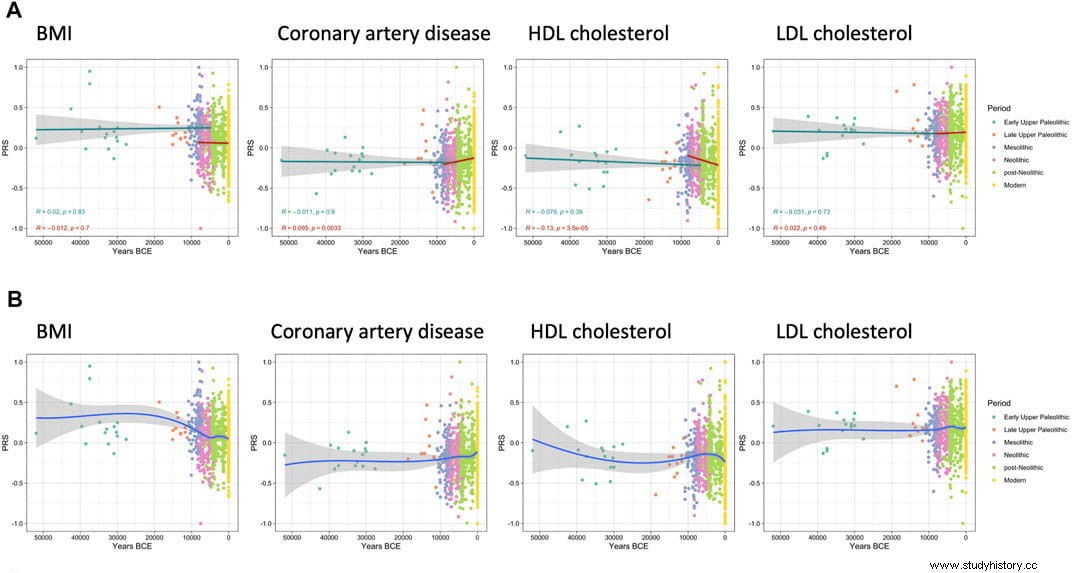After the Neolithic, European populations showed increased height and intelligence, decreased skin pigmentation, and increased risk of cardiovascular disease due to genetic changes that lowered concentrations of "good" HDL cholesterol. The changes reflect ongoing evolutionary processes in humans and highlight the impact the Neolithic revolution had on our lifestyle and health, researchers from Nijmegen and Hannover write in Frontiers in Genetics . The investigation of these past events offers interesting starting points for current science and health.
Like plants, animals, and other organisms, humans are dynamic organisms with variable traits. If we look at how human beings behave and look, we will see differences in skin color, eating habits, susceptibility to disease, height, etc. These outward traits are called a "phenotype." This appearance (phenotype) can be influenced, for example, by genetic factors, social and cultural habits, eating behavior and environmental factors.
The Nijmegen scientists, in collaboration with their colleagues at the Helmholtz Center for Infection Research (HZI, Hannover), investigated whether they could trace the development of some complex human traits of modern Europeans back to, say, 50,000 years BC. until the present. These are complex traits like height and intelligence. In this case, "complex" means that this trait is determined not by a single gene, but by dozens or even hundreds of genes. Each of these genes has a very small effect on that trait.
Genetic Archaeology
How can all the genes that interfere with height be traced? It can be done with a technique called GWAS:Genome-Wide Association Studies. All human genes (genome) are taken to see which genes have an effect on height. This is not a causal relationship (it is not known exactly how these genes influence height), but a statistical relationship (the same genes always appear when height is determined).
In a large population study, you can get a list of genes that are involved in human height and compare this list of genes from modern Europeans with those from our distant ancestors. Archaeological research has already unearthed more than 800 people whose DNA has been mapped. Ultimately, this reference gives you a kind of timeline of European height genes, where you can look for changes and turning points along the way.
Accelerate evolutionary processes
The researchers analyzed not only height, but also other complex traits such as skin pigmentation, weight/BMI, lipid metabolism, intelligence, and cardiovascular disease. «In general, we see a clear change in some of these features before and after the Neolithic Revolution, as if there were then an acceleration of the evolutionary processes «, says Mihai Netea, of Radboudumc.
The Neolithic is an important period in human development, often referred to as the Neolithic Revolution. The wandering hunter-gatherers gradually disappeared and were replaced by locally settled farmers, giving rise to a completely different lifestyle, a change in diet and different socio-cultural customs.

Height, skin color and cholesterol
Yang Li, Researcher at HZI:During this transition period, we not only found a clear change in body height, but also in skin color. Europeans, for example, have kept their dark skin color for a remarkably long time, and it really does lighten during this period. This may be due to migration from Middle Eastern populations with less pigmented skin. In many genes related to metabolism and the risk of cardiovascular diseases, we observe few changes, with only one obvious exception:HDL cholesterol - often called "good" cholesterol - shows a clear decrease. Increases the risk of arthrosclerosis, but there is also a relationship with intelligence .
Intelligence
There is a change in genetic factors that leads to the development of coronary artery disease through a decrease in HDL cholesterol. This raises the question of what is the evolutionary advantage of this lower concentration of HDL cholesterol. Li:Perhaps it is in the development of cognitive functions, because cholesterol is essential for the development and functioning of the brain. Some small changes in genes - called polymorphisms - in cholesterol metabolism have been linked to cognitive functions, while variations in HDL and LDL levels have been linked to changes in intelligence, learning and memory. These are hypotheses, not evidence, but they illustrate the importance of this research, in that we are exploring factors that may influence the development of complex human traits .
Useful for the present
This evolutionary research on changing human traits in Europeans' past may also be useful for the present. Netea:It helps us understand the physiology of contemporary humans and we can better tailor public health measures to specific populations .
Research has learned, for example, that Asian populations are already at increased risk of metabolic and cardiovascular complications with lower BMI compared to European populations. We can take it into account in prevention strategies.
Look at the massive migration from the countryside to the city, which is accompanied by important changes in social and cultural habits, eating behavior and environmental factors. What will it mean for important human physiological traits, for evolutionary pressures on human genes and traits, and for human disease in modern societies?
